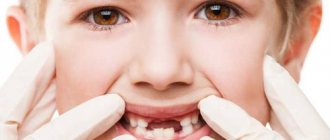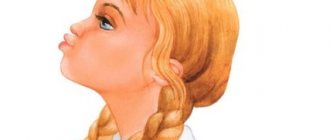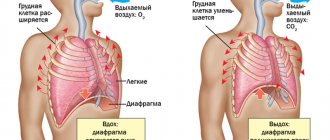Correction of rhinolalia necessarily includes sessions with a speech therapist.
Even if the cause of the speech disorder is not a functional lesion, but an organic one. Parents must understand that surgery alone will not help the child speak clearly and correctly. The operation only allows the speech organs to function correctly, but only a speech therapist can create sounds and form beautiful, clear diction.
Speech therapy plan for rhinolalia
The first stage is preoperative
It is advisable to begin classes with a speech therapist even before surgery. At this stage, the specialist will make efforts to create the sounds available in the child’s “arsenal” and will pay attention to general speech development and proper breathing. Since after surgery the main emphasis will be on developing new capabilities of the articulatory apparatus, you first need to eliminate incorrect movements of the facial muscles and prepare the skills of proper breathing and articulation.
The second stage is recovery after surgery
At this stage, classes are aimed at improving the mobility of the soft palate, correcting incorrect articulation, and practicing the pronunciation of vowel sounds.
The third stage is working on the pronunciation of all sounds, proper coordination of breathing and articulation
At this stage, work is carried out to establish the correct pronunciation of sounds and eliminate the habitual nasality of speech in the child. Exercises are carried out to improve phonemic hearing, and a lot of time is devoted to the grammatical structure of speech.
The fourth stage - automation of the delivered sounds
This period also takes a long time, since children with rhinolalia do not easily automate the correct sounds. The participation of the child’s parents is extremely important. Monitoring the completion of tasks and timely feedback from the teacher are a significant guarantee of achieving a good result.
Speech therapy classes are the main “weapon” for correcting rhinolalia caused by functional disorders, and no less important than a surgeon’s scalpel for organic rhinolalia. Regular exercises will help restore your child’s speech and give him every opportunity for successful communication and learning.
Diagnosis of rhinolalia
The examination of children and adults with rhinolalia is multifaceted and is carried out by various specialists:
- otolaryngologist;
- speech pathologist;
- speech therapist;
- neurologist;
- orthodontist;
- phoniatrist;
- pediatrician
An examination by specialized specialists allows us to identify the etiology of the disease, characterize as accurately as possible the nature of pathological changes and the severity of all symptoms. The following instrumental diagnostic methods are important:
- X-ray of the nasopharynx;
- rhinoscopy;
- electromyography;
- pharyngoscopy, etc.
These techniques make it possible to visualize the nature of pathological changes and their severity in each individual patient.
Of course, the most significant is an examination by a speech therapist, who, using a number of progressive techniques, will be able to assess the following parameters:
- structure of the articulatory apparatus;
- his mobility;
- voice disorders;
- parameters of physiological and phonation breathing, etc.
To diagnose open rhinolalia, the Gutzmann technique is used, which is based on the fact that the patient pronounces the sounds “a” and “i” alternately, while the doctor opens and closes the nasal passages. In the presence of pathological changes, the vibration of the wings of the nose is very clearly felt, and when the nasal passages are pinched, the sounds are significantly muffled. Thus, it is possible to diagnose the open form of rhinolalia.
Exercises to correct rhinolalia
Some types of classes should be carried out exclusively by a specialist. For example, in the postoperative period, in addition to breathing exercises, a special massage is also performed to restore the mobility of the soft palate. Parents should not do it themselves.
But many of the exercises can be repeated at home. Frequent “training” will help the child get used to it faster. However, it is important to follow the basic rules:
- classes should not overtire the child;
- his diligence must be supported by his family;
- all exercises must first be worked out with a speech therapist to eliminate the possibility of incorrect execution.
NeuroSpectrum is ready to help
The NeuroSpectrum Center for Pediatric Speech Neurology and Rehabilitation employs experienced speech therapists, speech pathologists and other doctors who will help you quickly identify the problem and determine the safest and most effective way to eliminate it. Our specialists have modern diagnostic and medical equipment at their disposal; they constantly improve their qualifications, improve their skills and abilities, so that they are able to cope with the most complex and advanced cases.
The specialists of our Center use different areas of speech therapy work for rhinolalia - a complex effect allows you to get the desired result much faster. Hundreds of our patients have gotten rid of problems with sound pronunciation and speech and today speak clearly, quickly, and confidently.
Breathing exercises
Rhinolalics are characterized by breathing with exhalation both through the mouth and through the nose. Therefore, teaching a child to control inhalation and exhalation is very important. To control, you can use a piece of cotton wool or a napkin applied to your nose. The purpose of the exercises is to teach you to “blow” only through your mouth.
Inhale - exhale
This exercise will help you learn to control your breathing. The child inhales and exhales in a strictly defined manner. For example, inhale and exhale through your nose, the next time you inhale and exhale only through your mouth. We complicate the task - inhale through the nose, exhale through the mouth, the next inhale-exhale through the nose, then only through the mouth. And so on.
Storm in a teacup
Playing with water will help to visually control your mouth breathing. Children enjoy blowing into the water through a straw, creating real storms and storms. To prevent the water from splashing, it is more convenient to take a bottle rather than a wide glass. Just be sure to be transparent so that the seething is clearly visible. When the child learns to blow into a tube, creating a gurgling sound, you need to try to lengthen the exhalation. For the storm to be “real,” the exhalation must be uniform and long.
Games for blowing out candles, kicking soccer balls made from cotton balls, various toy wind instruments and blowing up balloons are also very useful. However, what is important here is the gradual complication of the task and the absence of overload. Breathing exercises should not be long, so that the child does not feel dizzy.
Speech therapy work with children suffering from rhinolalia begins at 2-3 years of age and is carried out both in the preoperative and postoperative periods. If we keep in mind only rhinolalia (without taking into account the possible general underdevelopment of speech that accompanies it), then the ultimate goal of speech therapy work is to remove the nasal tone of the voice and develop correct sound pronunciation, which will ultimately ensure the normalization of the child’s speech function. However, neither one nor the other can be achieved without providing the necessary prerequisites. These include the development of mobility of the soft palate, the development of a sufficiently strong and prolonged oral exhalation, and the achievement of a forward position of the tongue. The creation of these prerequisites begins already in the preoperative period.
The main goal of preoperative speech therapy and a set of therapeutic measures is to prevent as much as possible those possible deviations in the development of the child, which are, as it were, predetermined, programmed by the very fact of the presence of a cleft, and also to prepare more favorable conditions for the operation. During this period, the main attention should be paid to the following.
1. Prevention of the appearance of asthenic syndrome. Since it is known in advance that children with congenital cleft palates are weakened and predisposed to colds, from a very early age it is necessary to take care of hardening the child and stimulating his physical development. Hardening is carried out from the very first months of life. For this purpose, you can use air baths, water procedures, and walks with the child in the air that gradually increase in duration, provided that their duration is gradually increased and the temperature does not fluctuate too sharply.
Stimulation of physical development is achieved mainly through outdoor games and special physical exercises. At the earliest stages of development, it is best to “follow” the course of normal ontogenesis, somewhat activating those movements that are available to a child of a given age. For example, if in the period from 6 to 10 months the child mainly crawls, then attention is focused on intensifying crawling. To stimulate this motor process, the child is asked to crawl either to his mother, or to his father, or to his grandmother, or for a bright toy. The distance can be gradually increased. At the appropriate age, approximately the same thing is done with walking and running. Hide and seek, ball and other outdoor games are used.
2. Prevention of tongue fixation in the wrong position. For this purpose, from the very first days of his life, they avoid placing the baby on his back, so that this position itself does not provoke the tongue to sink back. In the future, they try in every possible way to stimulate the movements of the tip and the front part of the back of the tongue (for example, you can systematically invite the child to lick jam from the upper lip, “brush teeth” with the tip of the tongue, play “clock”, moving the tongue sticking out of the mouth from one corner of the mouth to another and etc.).
The anterior position of the tongue is very important for educating the child already in the preoperative period of oral exhalation, since the root of the tongue, pulled deep into the oral cavity, prevents air from escaping through the mouth. Correct oral exhalation with the root of the tongue lowered allows you to completely remove the nasal connotation on a particular sound, and subsequently in the entire speech. The anterior position of the tongue and every possible activation of its tip are also necessary for the development of correct articulation of sounds, most of which in the Russian language are anterior lingual.
3. Prevention of respiratory dysfunction. Since with rhinolalia there is a leak of air through the nose and the exhalation itself is very shortened and wasteful, you need to try to prevent the final consolidation of this method of breathing. The main task is to develop a sufficiently long and economical, stable oral exhalation, which could be used to pronounce an entire phrase. For this purpose, special breathing exercises are used to prevent a decrease in the volume of inhaled and exhaled air and thereby prepare the child’s respiratory apparatus for normal speech load. Along with this, the child must be taught to breathe through the nose and not the mouth.
To develop the duration of oral exhalation, starting from the age of 1.5-2 years, you can teach your child to “chill tea”, “warm hands” with the warmth of your breath, blow on a sore spot, etc. Exercises such as “sniffing” contribute to the development of inhalation through the nose flower." In the future, you can use rolling round pencils on the table located at the level of the child’s mouth; playing the harmonica, blowing out a candle with a gradual increase in the distance to it, “blowing” fluff flying in the air, blowing away dandelions, etc. However, due to the great tediousness of breathing exercises, they are carried out for 1.5-2 minutes, but in the process of one classes are repeated several times. Breathing exercises, in addition to solving purely speech therapy problems, also contribute to more complete development of the child’s chest, and consequently, to strengthening his health
4. Activation of the muscles of the velopharyngeal ring. It is very important already in the preoperative period, since it significantly improves the conditions for the operation. Here you can recommend exercises such as coughing lightly, yawning, and swallowing small portions of milk or water. In this case, the soft palate (and before the operation - its fragments) reflexively rises upward. A finger massage of the segments of the hard and soft palate is also carried out, which the child’s mother is taught in the maternity hospital. These exercises are resumed two to three weeks after surgery, but even more attention is paid to activating the soft palate. In many cases, physiotherapy is also used for this purpose. The main goal of this work is to ensure closure of the soft palate with the posterior wall of the pharynx, which is necessary to achieve isolation of the nasal cavity from the oral cavity. Rhinolalia is a nasal tone of voice, accompanied by disturbances in sound pronunciation and caused by defects in the structure and functioning of the speech apparatus (rhinos, in Greek - nose, lalia - speech). Previously, the term “nasality” was used to denote this speech disorder, which has a folk origin and reflects the peculiarity of the external manifestation of the disorder.
Movement of the soft palate: A - the soft palate is raised and pressed tightly against the back wall of the pharynx. The timbre of the voice when pronouncing all speech sounds, except nasal ones, is normal; B - the soft palate is raised and pressed against the thickened posterior wall of the pharynx. Voice timbre is normal; B - the soft palate is not raised enough. There is no contact between the soft palate and the walls of the pharynx. Exhaled air freely penetrates into the nasal cavity. Voice timbre is nasal.
5. Development of mobility of articulatory muscles as a necessary prerequisite for developing the correct pronunciation of sounds. Concern about this should begin from a very early age. First, so-called passive movements are carried out. The mother uses her fingers to gather the child’s lips into a tube, and then stretches them into a smile; lifts the upper lip up, exposing the upper gums, after which the lower lip is lowered down, exposing the lower gums. At a later age, they gradually move on to actively performing these same movements by the child himself. Already in the preoperative period, in children with rhinolalia, it is essentially possible to develop the correct articulation of all speech sounds, although the nasal tone of the voice is preserved. But what is important here is that the child gets used to using articulate speech from the very beginning, and does not remain “speechless”, capable of making only mooing sounds. The correct position of the articulatory organs, brought up before the operation, is quickly restored and is more likely to be strengthened in the postoperative period, which significantly reduces the duration of speech therapy work after the operation.
6. Development of voice strength and flexibility. As already noted, the presence of a cleft palate in a child leads to the fact that his voice sounds quiet and muffled. Knowing this, it is necessary to take at least the simplest preventive and corrective measures as early as possible. You can play with your child in imitating the voices of different animals (for example, the low voice of a bear or the moo of a cow and the much higher voice of a cat meowing). It is also good to use “rocking a doll” with its characteristic alternation of higher and lower sounding sounds A. To involuntarily increase the strength of the voice, it is useful to move some distance away from the speaking child. However, all these exercises should be carried out very carefully, without any overstrain of the child’s weak vocal function.
7. Prevention of delayed speech and mental development of the child. This area of preoperative speech therapy is important because the presence of a cleft palate greatly limits the child’s speech communication capabilities and can secondarily cause a delay not only in speech, but also in mental development. To prevent this, it is necessary to attract the child’s attention to speech from a very early age, talk to him more, giving him the opportunity to see the speaker’s face, which will stimulate the need to imitate audible sounds. Later, you should work on expanding your understanding of the speech of others, enriching your vocabulary, clarifying the syllabic structure of words, paying special attention to the child’s correct pronunciation of their endings (prevention of agrammatisms).
8. Prevention of the appearance of secondary mental layers. This very important area of preoperative speech therapy consists of providing psychotherapeutic influence on the child and his immediate family. From the very first days of a child’s life, such an impact is exerted on his parents and, above all, on his mother. A detailed explanatory conversation is held regarding the structure of the speech apparatus and those measures to normalize the child’s appearance and speech that will need to be taken in the future. It is advisable to show photographs of children with cleft lips and palates before and after surgery, as well as to listen to tape recordings of their impaired and normal speech. The general conclusion from this initial conversation, which is quite consistent with the real state of affairs, should be this: everything will return to normal, but only for this it will be necessary to make the necessary efforts over a more or less long period of time. From the very beginning, parents need to be tuned not to worries, but to greater internal self-discipline and activity. Correct behavior of parents towards the child can minimize the need for psychotherapy with him. Otherwise, psychotherapy is carried out not only with the parents, but also with the child.
In the postoperative period, basically the same areas of speech therapy work are maintained and the previously achieved results are consolidated in the new conditions. To prevent the formation of hard postoperative sutures that limit mobility, it is important to carry out active digital massage of the soft palate along the suture line by intermittent pressure on it in order to knead the scar tissue. Light stroking movements are also made on the velum palatine, and light blows are made on it to stimulate innervation.
Subsequently, the nose and mouth no longer close, but both inhalation and exhalation are carried out only through one of the named resonators. At this stage of work, a wide variety of combinations of differentiated inhalations and exhalations are recommended. For example:
• inhale through the mouth and exhale through the mouth;
• inhale through the nose and exhale through the nose;
• inhale through the mouth, exhale through the nose;
• inhale through the nose, exhale through the mouth.
To achieve better performance results and increase the child’s interest in performing the exercises correctly, visual control is used: a narrow strip of thin paper (such as tissue paper) is placed under the very nasal passages, which should remain completely motionless when exhaling correctly through the mouth. The deviation of this piece of paper will indicate that part of the exhaled air is coming out through the nose, which should not be the case.
In addition to visual control, auditory control is gradually developed - the child is trained in distinguishing between a normal-sounding voice and a voice with a nasal tint. At first, you can use the imitation of one or another method of voice production by the speech therapist himself. At the same time, the child determines each time which of the phrases was pronounced correctly and which was not. Developing this skill is very important for subsequent self-control of speech, since a child with rhinolalia cannot hear the nasal sound of his voice.
In the postoperative period, much attention is also paid to the correction of sound pronunciation, during which previously developed skills of correct articulation of sounds are widely used and finally consolidated. At the same time, in the process of correcting each individual sound, in addition to monitoring the correct position of the articulatory organs, special attention is paid to removing nasalization.
At the final stage of work, much attention is paid to the complete automation of correct speech skills. At this stage, control over the child’s speech outside the speech therapy room plays an extremely important role, in which parents must provide literally indispensable assistance. Equally important is the child’s self-control, in whose upbringing parents should again help by constantly drawing the child’s attention to the nasal tone of his voice that periodically appears in his voice.
The effectiveness of speech therapy work to overcome rhinolalia largely depends on the results of the operation - the extent to which it was possible to restore the anatomical structure of the hard and soft palate and ensure the mobility of the soft palate. In addition, the psychophysical state of the child, the characteristics of his behavior and character, his attitude to classes and the degree of assistance to the speech therapist from the parents are very important for achieving a positive result.
Articulation exercises
To correct articulation disorders caused by rhinolalia, special exercises are needed:
- “Snake or spade” - you need to learn to stick out your tongue with a pointed tip, and then widely flattened. The next stage is to alternate between “snake” and “shovel”.
- “Bend the back” - the tip of the tongue rests on the lower gums, and the back of the tongue curves up and down.
- “Inflate and deflate” - the cheeks need to be inflated and deflated, pulling them between the teeth. As an option, learn to inflate not both cheeks at once, but alternately. An adult can help deflate the puffy cheek by lightly touching it with a finger.
- “Rinse your teeth” - imitate rinsing your teeth without water (the air should press on your lips).
- “Elephant exercise” - the child must learn to hold his lips closed and extended forward with his “proboscis”, and then move it left and right and even rotate it.
Staging sounds
The vowels begin to be practiced first - first A, and after it E, O, U, I. The child learns to correctly pronounce sounds in isolation, one at a time, gradually connecting them together.
Exercises:
- Pronounce the sound once while exhaling.
- After some time, the teacher suggests increasing the number of repetitions per exhalation.
- Alternating combinations of vowels - the child pronounces already mastered sounds together.
- In the process of practicing, children pronounce sounds in “different voices” - low (like a wolf or a bear), high (like a bird or a bunny), at a normal level.
After practicing vowel sounds and mastering proper breathing and articulation, the speech therapist moves on to the production of consonants. The first sound in line is F. Then they begin to work on voiceless fricatives and plosives, voiced, occlusive fricatives and sonorants. However, of course, in each specific case the sequence of sound production is determined by the speech therapist depending on the situation.
Exercises for automating sounds must be built from simple to complex and based on already learned phonemes, so that it is not difficult for the child to practice.
A good option for practicing pronunciation is singing. When a child sings, the velum closes on its own, which means it becomes possible to pay more attention to controlling the pronunciation of phonemes.
Exercises to develop phonemic awareness
- "Who is there?" - the child is asked to close his eyes and recognize musical instruments, sounding toys, and people’s voices by ear. Important: he must know all these sounds well before.
- “Repeat” - the teacher invites the child to repeat after him a set of identical syllables with the emphasis on the first vowel (mA-ma-ma), then on the second (ma-ma-ma) and on the third.
- “Find the mistake” - children love to “correct” adults, so this game is usually popular. The teacher reads the text, and the child must “convict” the author of the mistake. For example: Our Mishka has a big chip (bump) on his forehead.
Classes do not include all exercises at the same time. The speech therapist selects the necessary ones depending on the specific situation and the child’s readiness.
Publication date: 05/31/2017. Last modified: 05/09/2018.
COMPREHENSIVE SURVEY
Diagnosis of children with rhinolalia requires an integrated approach and involves examination by several doctors at once.
The general diagnostic system includes step-by-step analysis:
- Familiarization with personal file data.
- Collection of anamnestic data (information obtained through questioning).
- Review of all doctors' reports.
- Conducting a conversation with the child and parents.
- Development of a correction program.
- Formation of a speech map.








